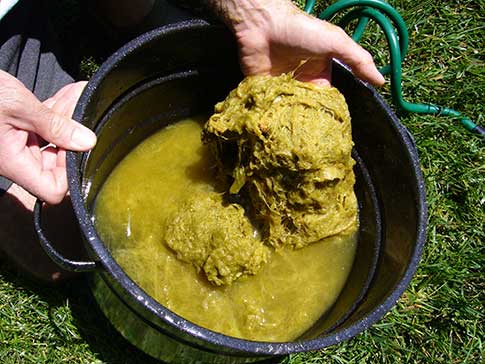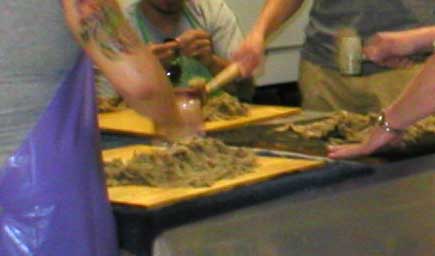One of the most interesting aspects of the hand-papermaking process has been taking raw plant fibers and turning them into paper. This is an intensely laborious process, which the class experienced firsthand. The fiber can be green or dried, but it must be cooked for up to several hours in an alkali (most commonly soda ash or lye) solution. Some fibers are helped along by first going through a “retting,” or fermentation process. This can be as simple as just leaving them outside on the ground for a couple of months through the fall and/or winter, or as complex as creating a special container that stays outside in the heat and must be monitored and stirred regularly.
The class collected iris, both fresh and dried, cattail leaves and catkins (I had to look up the word!), and a big bag of corn husks from the grocery store. I contributed a load of dried daylily leaves that I had used to store some bulbs in the basement last winter. Since I already have a large quantity of soda ash from my fabric dyeing days, I volunteered to do some cooking.
It’s best to do this outside if possible. After first experimenting with a hot plate, we found the most efficient way to get the necessary heat was on the gas burner of our propane grill. These are the cooked iris and daylily fibers, above. The iris, since it was green, took only a little over an hour to cook, while the dried daylily leaves took over 3 hours.
After that, it’s tons of rinsing to get rid of all the soda ash plus the non-cellulose materials that have cooked out of the fiber. My husband, who is incredibly supportive of all my crazy art schemes, helped me with this, and models the iris during the rinsing process, above. The color started out looking very much like asparagus. I hoped it would stay that way for the paper, but sadly, it faded to pastel. I felt really bad about all the water we used for rinsing, but at least we did most of it on the grass.
After cooking and rinsing comes beating. Some of this was done with the Hollander beater, some with blenders, but a great deal of it was done by hand with baseball bats, various mallets, and meat tenderizers. (This photo was taken by Carrol Reeves, my friend from class, who became our unofficial photographer.) The hand beating took many hours, and everyone participated in it at some point. To test for doneness, you take a pinch from a couple of different areas of your pile, put them in a jar with a lot of water, and shake it up. When all the fibers move freely without clumping, it’s done and ready to be made into paper.
<tangent alert>
Since taking this class, I’ve got my own opinion now that the terms “art quilter” and “fiber artist” are in no way synonymous. In quilting and textile work, artists are dealing pretty much only with fabrics and threads which have already been manufactured in a mill or factory somewhere else. In papermaking, we are dealing with fibers on a much lower level, working with the raw plant material in some cases, processing the fibers from scratch into a material that can then be made into art. I think that unless I start incorporating “fibers” other than fabric and thread into my work, it is not appropriate to call myself a “fiber artist.” I welcome your thoughts on this topic.
</tangent>




eeww, looks like bad cafeteria food!
Sorry, my visceral reaction got the best of me and I forgot the more important question. I’ve never really liked the term Fiber artist, and now you’ve given me another great term not to use it.
Actually I don’t really like either term, I’d prefer to call my self an artist and leave off the other stuff.
Thanks!
Yes, “artist” without any qualifiers does seem like a good way to handle it. You’ve opened the door to further conversation about your medium without immediately sending the person down a path it’s hard to get them back from.